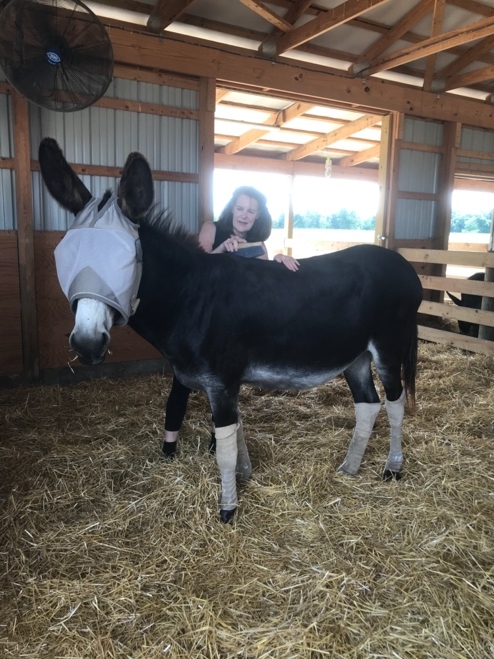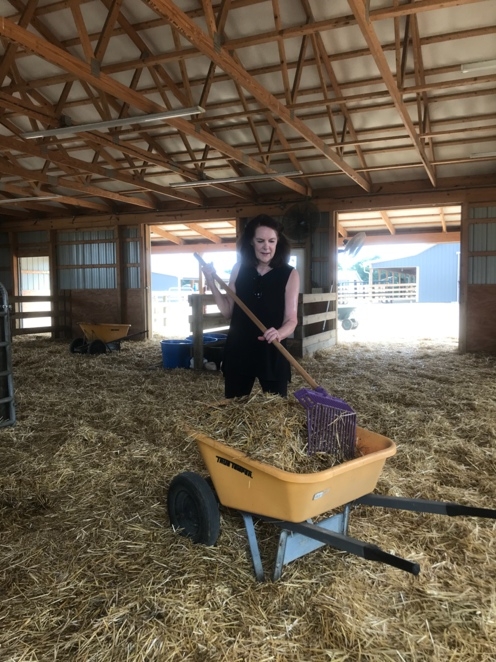Here I am as a volunteer at Little Longears in New Oxford, PA. I had the most amazing day. You can volunteer too! Or consider making a contribution to help the donkeys in their care.

Little Longears is dedicated to the rescue, rehabilitation and safe sanctuary of abused, neglected or otherwise unwanted donkeys. We also provide a safe haven for owners to surrender their donkeys in the event they are no longer able to care for them.
The owners and founders of Little Longears Donkey Rescue are Valerie Lowe and Cheryl Pokorny.
Valerie went from being an A-circuit hunter/jumper trainer, showing, riding, teaching, and running her own business, to becoming the co-founder and director of Little Longears Miniature Donkey Rescue. And Cheryl is a retired high school PE teacher and loves all things DIY. Her home renovation skills even landed her on HGTV’s “All American Handyman” in 2011.
I learned a great deal from visiting with Val and Cheryl and can’t wait to go back! And the tour was awesome. I was there with about 15 other visitors and we spent time learning, watching, listening and petting. Yes, lots of petting. A very special place to take your children and the whole family!

![]()
Here’s Erika, a volunteer I worked alongside at Little Longears Donkey Rescue!
/in Donkeys! /by PMSmasterErika drives every month from Maryland to New Oxford, PA to lend a hand. She also sponsors a donkey named Brighty. When Erika sat down out in the field, all the donkeys strolled over to get petted! Erika began volunteering at Little Longears back when their rescue farm was in Maryland. When they moved to New Oxford, PA, Erika decided to make the trip every few weeks to continue to volunteer!
Why rescue miniature donkeys? Do these animals really need our help?
/in Donkeys! /by PMSmasterIt’s easy to see why people fall in love with these cute, adorable little guys. They are kind and sweet, gentle and playful. They are basically very easy and fairly inexpensive to care for. They make great pets and wonderful companions for other equines.
However, people forget that donkeys can live upwards of 40 years, and having one is a lifelong commitment. As pets for children the novelty often wears off, leaving them forgotten in the pastures. They keep weight on with very little to eat, but their feet often go completely ignored for years, leading to long, curly, disfigured hooves, causing pain and lameness. Lack of good dental care results in sharp, painful teeth, eventually leading to difficulty eating. Though these guys are stoic, tough little survivors, that does not mean that they don’t suffer when neglected.
Why not sponsor a donkey with your whole family? It makes a wonderful gift for family and friends… or make a one-time donation. Every penny helps!
You can also visit a donkey farm near you! It is an incredible experience for children and the entire family of all ages!
You can sponsor a donkey too…
/in Donkeys! /by PMSmasterI sponsor Big Clyde, a mammoth donkey! He was rescued by Little Longears Donkey Rescue in New Oxford, PA.
You can sponsor a donkey too! I felt honored to be able to spend time with Big Clyde once I knew his history.
Big Clyde was the oldest member of a group of mammoth donkeys to which we alerted officials in 2016. Big Clyde had many years of neglect before he arrived here, and sometimes his rough past catches up with him. He requires a lot of specialized care to keep him comfortable and healthy. Big Clyde’s booming bray at feeding time is unmistakable, and we know he’s happy here with his friends, where he gets all the vet and farrier care he needs so that he can live the best life possible.
Here I am as a volunteer at Little Longears in New Oxford, PA.
/in Donkeys! /by PMSmasterHere I am as a volunteer at Little Longears in New Oxford, PA. I had the most amazing day. You can volunteer too! Or consider making a contribution to help the donkeys in their care.
Little Longears is dedicated to the rescue, rehabilitation and safe sanctuary of abused, neglected or otherwise unwanted donkeys. We also provide a safe haven for owners to surrender their donkeys in the event they are no longer able to care for them.
The owners and founders of Little Longears Donkey Rescue are Valerie Lowe and Cheryl Pokorny.
Valerie went from being an A-circuit hunter/jumper trainer, showing, riding, teaching, and running her own business, to becoming the co-founder and director of Little Longears Miniature Donkey Rescue. And Cheryl is a retired high school PE teacher and loves all things DIY. Her home renovation skills even landed her on HGTV’s “All American Handyman” in 2011.
I learned a great deal from visiting with Val and Cheryl and can’t wait to go back! And the tour was awesome. I was there with about 15 other visitors and we spent time learning, watching, listening and petting. Yes, lots of petting. A very special place to take your children and the whole family!
Little Longears!
/in Donkeys! /by PMSmasterI’d like to introduce you to:
Little Longears Miniature Donkey Rescue Inc.
New Oxford, PA
www.littlelongears.org
601-454-5956
Youtube channel:
https://www.youtube.com/channel/UChyeCYG2cZA4-X9V6qveYdw
Little Longears Miniature Donkey Rescue is a paradise for donkeys, located in New Oxford, PA on 100 acres.
Learn & Play! with Five Little Ducks Felt Board & Song
/in Blog /by PMSmasterFive Little Ducks, included on my ‘I Like to Sing’ CD, is one of my favorite songs for play with movement, storytelling and felt. It’s great for working with adding and subtracting, and playing with hide and seek when the ducks disappear behind the hill on each verse.
You can create your very own ‘Five Little Ducks’ felt storyboard to use at home or in the classroom while you sing along with the song!
You’ll need to purchase a 9×12 inch adhesive foam board(s), adhere a 9×12 inch background color felt on the board, and cut the felt ducks and other shapes out of additional colorful pieces of felt. You can sing the song while you move the felt pieces on and off the board along with the lyrics.
When you’ve finished with the story/play and boards, simply store the small pieces in zip lock bags, and place the boards in a safe place for next time!
Here’s a link to order my ‘Five Little Ducks song!
And the link to order my ‘Five Little Ducks’ Craft Kit!
Learn & Play! with The Story of Little Flame in the Arctic Felt Board, Book & Song
/in Blog /by PMSmasterThe Story of Little Flame in the Arctic, included on my latest Five Little Oysters CD release, is the story of a little flame who lives far to the north and shines her light in the nighttime sky for all who need it to see.
You can create your very own Story of Little Flame felt storyboard to use at home or in the classroom while you listen to and recreate the story. You’ll need to purchase a 9×12 inch adhesive foam board(s), adhere a 9×12 inch background color felt on the board, and cut the felt flame, mountain, stars and animals out of additional colorful pieces of felt. You can listen to and tell the story while you move the felt pieces on and off the board in any way you wish.
When you’ve finished with the story and boards, simply store the small pieces in zip lock bags, and place the boards in a safe place for next time!
Here’s a link to order my ‘The Story of Little Flame in the Arctic’ song!
And here’s a link to order my ‘The Story of Little Flame in the Arctic’ audio picture book!
Learn & Play! with The Ants Go Marching Felt Board, Book & Song
/in Blog /by PMSmasterThe Ants Go Marching song included on my latest Five Little Oysters CD release is one of my favorite traditional melodies. This song features counting from one to five, while marching, storytelling, and keeping time with the music.
You can create your very own felt storyboard to use at home or in the classroom while you sing and march with the song. Purchase a 9×12 inch adhesive foam board(s), adhere a 9×12 inch background color felt on the board, and then cut the felt ants and other shapes from the story/song out of additional colorful pieces of felt. You can sing, count, and add the ants on and off the board in any way you wish as you sing along.
When you’re finished with the song/play and boards, simply store the small pieces in zip lock bags, and place the boards in a safe place for next time!
Here’s a link to order my ‘The Ants Go Marching’ song!
And here’s a link to order my ‘The Ants Go Marching’ audio picture book!
Learn & Play! with Five Little Oysters Felt Board, Book & Song
/in Blog /by PMSmasterFive Little Oysters, the title song on my latest CD release, features one of my favorite songs for stimulating learning play with children ages 2-5. The song features counting/ adding and subtracting, rhythmic listening, rolling movement for hands and whole body, and active storytelling.
While you sing, you can create your very own felt storyboard to use at home or in the classroom. Purchase a 9×12 inch adhesive foam board(s), adhere a 9×12 inch background color felt on each board, and then cut felt oysters, sand and waves from colorful pieces of felt. You can sing, count, add and subtract the oysters, put the oysters on and off the board, and manipulate the felt play in any way you wish!
When you’re finished with the song/play and boards, simply store the small pieces in zip lock bags, and place the boards in a safe place for next time!
Here’s a link to order my Five Little Oysters song!
And here’s a link to order my Five Little Oysters audio picture book!
My Guest Blog Post at Rockmommy!
/in Blog /by PMSmasterI was pleased to contribute a blog post to the Rockmommy website, all about the Importance of Movement, Learning and Growing…
Thank you Marisa!
Read it here!